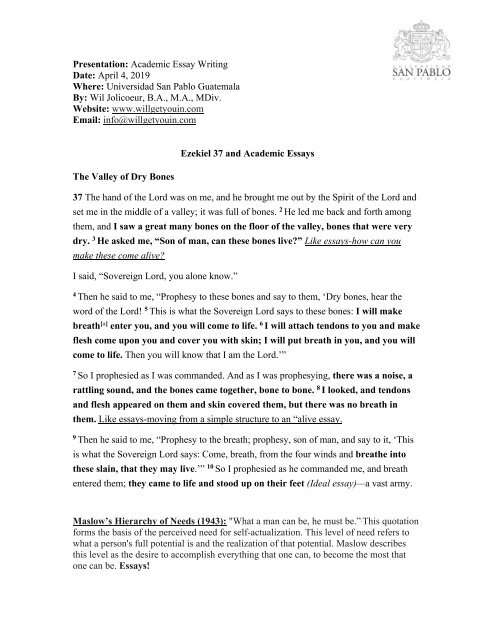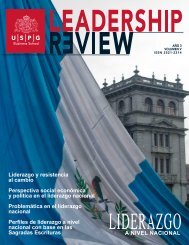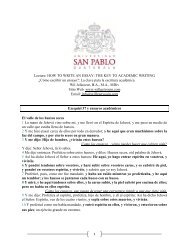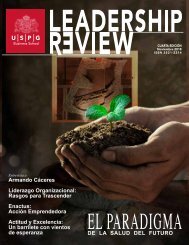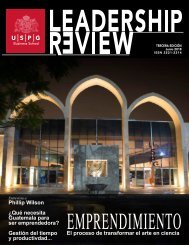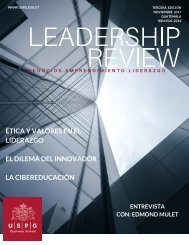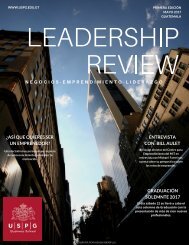Presentation Academic Essay Writing
Date: April 4, 2019 Where: Universidad San Pablo Guatemala By: Wil Jolicoeur, B.A., M.A., MDiv.
Date: April 4, 2019
Where: Universidad San Pablo Guatemala
By: Wil Jolicoeur, B.A., M.A., MDiv.
Create successful ePaper yourself
Turn your PDF publications into a flip-book with our unique Google optimized e-Paper software.
<strong>Presentation</strong>: <strong>Academic</strong> <strong>Essay</strong> <strong>Writing</strong><br />
Date: April 4, 2019<br />
Where: Universidad San Pablo Guatemala<br />
By: Wil Jolicoeur, B.A., M.A., MDiv.<br />
Website: www.willgetyouin.com<br />
Email: info@willgetyouin.com<br />
Ezekiel 37 and <strong>Academic</strong> <strong>Essay</strong>s<br />
The Valley of Dry Bones<br />
37 The hand of the Lord was on me, and he brought me out by the Spirit of the Lord and<br />
set me in the middle of a valley; it was full of bones. 2 He led me back and forth among<br />
them, and I saw a great many bones on the floor of the valley, bones that were very<br />
dry. 3 He asked me, “Son of man, can these bones live?” Like essays-how can you<br />
make these come alive?<br />
I said, “Sovereign Lord, you alone know.”<br />
4<br />
Then he said to me, “Prophesy to these bones and say to them, ‘Dry bones, hear the<br />
word of the Lord! 5 This is what the Sovereign Lord says to these bones: I will make<br />
breath [a] enter you, and you will come to life. 6 I will attach tendons to you and make<br />
flesh come upon you and cover you with skin; I will put breath in you, and you will<br />
come to life. Then you will know that I am the Lord.’”<br />
7<br />
So I prophesied as I was commanded. And as I was prophesying, there was a noise, a<br />
rattling sound, and the bones came together, bone to bone. 8 I looked, and tendons<br />
and flesh appeared on them and skin covered them, but there was no breath in<br />
them. Like essays-moving from a simple structure to an “alive essay.<br />
9<br />
Then he said to me, “Prophesy to the breath; prophesy, son of man, and say to it, ‘This<br />
is what the Sovereign Lord says: Come, breath, from the four winds and breathe into<br />
these slain, that they may live.’” 10 So I prophesied as he commanded me, and breath<br />
entered them; they came to life and stood up on their feet (Ideal essay)—a vast army.<br />
Maslow’s Hierarchy of Needs (1943): "What a man can be, he must be.” This quotation<br />
forms the basis of the perceived need for self-actualization. This level of need refers to<br />
what a person's full potential is and the realization of that potential. Maslow describes<br />
this level as the desire to accomplish everything that one can, to become the most that<br />
one can be. <strong>Essay</strong>s!
Aristotle (384 BC): “Each human being is bred with a unique set of potentials that yearn<br />
to be fulfilled as surely as the acorn yearns to become the oak within it.” <strong>Essay</strong>s are the<br />
acorns!<br />
Short and Long-Term Goals:<br />
They must be specific and match. Do you want to be successful specifically and if so, do<br />
you short-term goals provide evidence of that. For example: God has a long-term goal or<br />
plan for us but do our short-term goals provide evidence that we are working towards<br />
God’s plan for us? Acorns or oak trees?<br />
<strong>Academic</strong> essays and research follow this as well. Use this logic as well. Do you want to<br />
write a great essay? If not, the quality of that essay will reflect your unclear long-term<br />
goal.<br />
1. Most important: Mirror and borrow writing styles from writers. When you<br />
read, pay attention to how they use sentence structure. Memorize three essays<br />
that you like and use some of that sentence structure.<br />
2. <strong>Essay</strong>s are templates that are simply modified<br />
Harvard <strong>Writing</strong>: Keep your thesis prominent in your introduction. A good,<br />
standard place for your thesis statement is at the end of an introductory paragraph,<br />
especially in shorter (5-15 page) essays. Readers are used to finding theses there, so they<br />
automatically pay more attention when they read the last sentence of your introduction.<br />
Although this is not required in all academic essays, it is a good rule of thumb.<br />
What is a Thesis?<br />
A thesis statement is a sentence in which you state an argument about a topic and<br />
then describe, briefly, how you will prove your argument.<br />
<br />
<br />
This is an argument, but not yet a thesis: "The movie ‘JFK’ inaccurately portrays<br />
President Kennedy."<br />
This is a thesis: "The movie ‘JFK’ inaccurately portrays President Kennedy because<br />
of the way it ignores Kennedy’s youth, his relationship with his father, and the<br />
findings of the Warren Commission."
Structure of the Response <strong>Essay</strong><br />
The Analysis of an Argument fleshes out the argument with an introduction, three core<br />
paragraphs dissecting and evaluating the argument, and a conclusion.<br />
Paragraph 1 introduces your main ideas and your central thesis. This is the place to state<br />
your overall argument in summary. You might want to write this last or come back to it<br />
when you're done in order to revise it.<br />
Paragraphs 2, 3, and 4 flesh out your analysis of the argument and propose counterarguments<br />
and examples.<br />
Paragraph 5 sums everything up. You might want to write this first. Your conclusion<br />
should summarize your main points but also offer further insight into the nature of the<br />
debate's logical dilemma.<br />
Let's examine a potential sample argument you could encounter while taking the GMAT<br />
and the strategies to craft a compelling response.<br />
Example Argument<br />
The trade-off between privacy and national security has been a hot topic since Edward<br />
Snowden leaked information about the NSA surveillance program code named PRISM. In<br />
the wake of the revelation that the government has surreptitious access to citizens'<br />
private data, advocates of national security need to reinforce the value of American<br />
patriotism. The threat of terrorist activity at home and abroad by such groups as Al-<br />
Qaeda and ISIS outweighs the rights of American citizens outlined in the U.S.<br />
Constitution and Bill of Rights.<br />
Ask yourself the following questions:<br />
<br />
<br />
<br />
What assumptions does the author make?<br />
What are the argument's premises?<br />
What examples does the argument mention?<br />
Do not base your response on opinion. Whether or not you believe the argument is true,<br />
your task is to explore alternative readings of the argument's premises and reveal the<br />
logic (or lack of logic) in the argument's underlying assumptions.<br />
Premises and Underlying Assumptions<br />
The above argument is based on several premises, or propositions that appeal to the<br />
veracity of the argument. The author clearly states that national security is more<br />
important than individual privacy. The argument insists that American citizens need to<br />
sacrifice their 'inalienable rights' for the country's safety. The author also mentions two<br />
important documents that form the bedrock of American democracy: the Bill of Rights<br />
and the U.S. Constitution. The argument insinuates that these documents are amendable<br />
and (in the extreme) unimportant to the 21st century circumstances of national security.
Counter-arguments and Alternative Readings<br />
A counter-argument to the pro-security debate takes the contrary position. An ACLU<br />
lawyer might respond by stating:<br />
It is the government's responsibility to protect its citizens, as stipulated in the<br />
Constitution and Bill of Rights. These esteemed documents are important to uphold,<br />
despite 21st century threats of domestic terrorism. We cannot sacrifice our inalienable<br />
rights for a safety blanket. In the 'Declaration of Independence', our founding fathers<br />
enumerated these inalienable rights in the Constitution with this unforgettable phrase:<br />
'Life, Liberty, and the Pursuit of Happiness.' A federal agenda that favors national<br />
security over privacy would harshly infringe on the rights of all American citizens.<br />
Sample Analysis of an Argument Problem<br />
Evaluate the argument and plan a response before you begin writing<br />
• Organize your ideas and develop them fully<br />
• Provide relevant supporting reasons and examples<br />
Question:<br />
The following appeared in the editorial section of a monthly business news magazine:<br />
"Most companies would agree that as the risk of physical injury occurring on the job<br />
increases, the wages paid to employees should also increase. Hence it makes financial<br />
sense for employers to make the workplace safer: they could thus reduce their payroll<br />
expenses and save money."<br />
Discuss how well reasoned you find this argument. In your discussion be sure to analyze<br />
the line of reasoning and the use of evidence in the argument. For example, you may need<br />
to consider what questionable assumptions underlie the thinking and what alternative<br />
explanations or counterexamples might weaken the conclusion.<br />
You can also discuss what sort of evidence would strengthen or refute the argument, what<br />
changes in the argument would make it more logically sound, and what, if anything,<br />
would help you better evaluate its conclusion.<br />
Answer<br />
The following is an actual essay that received the highest rating:<br />
This argument states that it makes financial sense for employers to make the<br />
workplace safer because by making the workplace safer then lower wages could<br />
be paid to employees. This conclusion is based on the premise that as the list of<br />
physical injury increases; the wages paid to employees should also increase.<br />
However, there are several assumptions that may not necessarily apply to this<br />
argument. For example, the costs associated with making the workplace safe<br />
must outweigh the increased payroll expenses due to hazardous conditions. Also,
one must look at the plausibility of improving the work environment. And<br />
finally, because most companies agree that as the risk of injury increases so will<br />
wages doesn't necessarily mean that all companies, which have hazardous work<br />
environments, agree.<br />
The first issue to be addressed is whether increased labor costs justify large<br />
capital expenditures to improve the work environment. Clearly one could argue<br />
that if making the workplace safe would cost an exorbitant amount of money in<br />
comparison to leaving the workplace as is and paying slightly increased wages<br />
than it would not make sense to improve the work environment. For example, if<br />
making the workplace safe would cost $100 million versus additional payroll<br />
expenses of only $5,000 per year, it would make financial sense to simply pay<br />
the increased wages. No business or business owner with any sense would pay all<br />
that extra money just to save a couple dollars and improve employee health and<br />
relations. To consider this, a cost benefit analysis must be made. I also feel that<br />
although a cost benefit analysis should be the determining factor with regard to<br />
these decisions making financial sense, it may not be the determining factor with<br />
regard to making social, moral and ethical sense.<br />
This argument also relies on the idea that companies solely use financial sense in<br />
analyzing improving the work environment. This is not the case. Companies look<br />
at other considerations such as the negative social ramifications of high on-job<br />
injuries. For example, Toyota spends large amounts of money improving its<br />
environment because while its goal is to be profitable, it also prides itself on high<br />
employee morale and an almost perfectly safe work environment. However,<br />
Toyota finds that it can do both, as by improving employee health and employee<br />
relations they are guaranteed a more motivated staff, and hence a more efficient<br />
staff; this guarantees more money for the business as well as more safety for the<br />
employees.<br />
Finally one must understand that not all work environments can be made safer.<br />
For example, in the case of coal mining, a company only has limited ways of<br />
making the work environment safe. While companies may be able to ensure<br />
some safety precautions, they may not be able to provide all the safety measures<br />
necessary. In other words, a mining company has limited ability to control the air<br />
quality within a coal mine and therefore it cannot control the risk of employees<br />
getting Blacklung. In other words, regardless of the intent of the company, some<br />
jobs are simply dangerous in nature.<br />
In conclusion, while at first it may seem to make financial sense to improve the<br />
safety of the work environment sometimes it truly does not make financial sense.<br />
Furthermore, financial sense may not be the only issue a company faces. Other<br />
types of analyses must be made such as the social ramifications of an unsafe<br />
work environment and the overall ability of a company to improve that<br />
environment (i.e., coal mine). Before any decision is made, all these things must<br />
be considered, not simply the reduction of payroll expenses.


